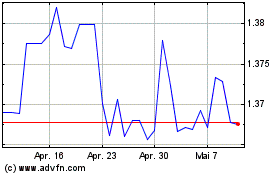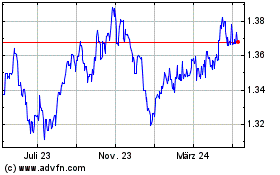Commodity Currencies Slide As Asian Stock Markets Traded Lower
03 September 2024 - 7:25AM
RTTF2
The Commodity currencies such as the Australia, the New Zealand
and the Canadian dollars weakened against their major currencies in
the late Asian session on Tuesday, as Asian stock markets traded
lower, giving up early gains due to jitters over China's economy
and a significant escalation of geopolitical tensions after two
crude oil tankers, the Saudi-flagged Amjad and Panama-flagged Blue
Lagoon I, were attacked in the Red Sea by Yemen's Iran-backed
Houthi rebels.
Meanwhile, intense diplomatic efforts are underway involving the
United States, Egypt and Qatar to secure a ceasefire in Gaza.
Oil and gold prices dipped in Asian trading as the dollar
extended its rebound ahead of the release of manufacturing and
service PMI readings.
Investors cautiously await more U.S. economic data, including
Friday's non-farm payrolls report for August to gauge the size of
the Federal Reserve's rate cut later this month.
In the late Asian trading today, the Australian dollar fell to a
6-day low of 1.6427 against the euro and a 4-day low of 98.39
against the yen, from Friday's closing quotes of 1.6300 and 99.75,
respectively. If the aussie extends its downtrend, it is likely to
find support around 1.68 against the euro and 92.00 against the
yen.
Against the U.S. and the Canadian dollars, the aussie slipped to
nearly a 2-week low of 0.6730 and nearly a 3-week low of 0.9105
from last week's closing quotes of 0.6790 and 0.9160, respectively.
On the downside, 0.65 against the greenback and 0.88 against the
loonie are seen as the next support levels for the aussie.
The aussie edged down to 1.0875 against the NZ dollar, from
Friday's closing value of 1.0892. The AUD/NZD pair may test support
near the 1.07 region.
The NZ dollar fell to nearly a 2-week low of 0.6183 against the
U.S. dollar, from Friday's closing value of 0.6230. The NZD/USD
pair is likely to find its support level around the 0.59
region.
Against the euro and the yen, the kiwi slipped to a 6-day low of
1.7877 and a 5-day low of 90.28 from last week's closing quotes of
1.7759 and 91.52, respectively. If the kiwi extends its downtrend,
it is likely to find support around 1.85 against the euro and 85.00
against the yen.
The Canadian dollar fell to nearly a 2-week low of 1.3531
against the U.S. dollar, from Friday's closing value of 1.3491. The
loonie is likely to find its support around the 1.36 region.
Against the euro and the yen, the loonie slid to a 5-day low of
1.4960 and a 4-day low of 107.80 from last week's closing quotes of
1.4936 and 108.85, respectively. If the loonie extends its
downtrend, it is likely to find support around 1.51 against the
euro and 104.00 against the yen.
Meanwhile, the safe-haven currency or the yen rose against its
major counterparts in the Asian session amid risk aversion.
The yen rose to a 4-day high of 145.65 against the U.S. dollar,
from an early 2-week low of 147.21. The yen may test resistance
around the 144.00 region.
Against the Swiss franc, the euro and the pound, the yen
advanced to 4-day highs of 170.77, 160.94 and 191.08 from early
highs of 172.67, 162.80 and 193.37, respectively. If the yen
extends its uptrend, it is likely to find resistance around 169.00
against the franc, 160.00 against the euro and 189.00 against the
pound.
Looking ahead, U.S. and Canada S&P Global manufacturing PMI
reports for August, U.S. Redbook report, ISM manufacturing PMI for
August and U.S. construction spending for July are slated for
release in the New York session.
US Dollar vs CAD (FX:USDCAD)
Forex Chart
Von Dez 2024 bis Jan 2025

US Dollar vs CAD (FX:USDCAD)
Forex Chart
Von Jan 2024 bis Jan 2025
